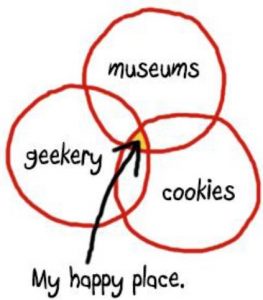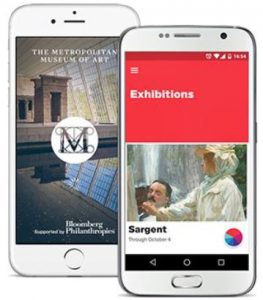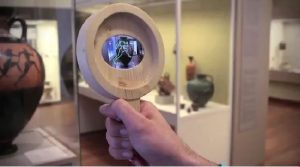
Sabrina Greupner is the Ontario Science Centre’s Cisco Science Fellow for Innovative Learning Technologies. This is Cisco’s first museum-based fellowship.
 If you’re in the center of that magical Venn diagram where geeks and museum staff overlap, there are two gatherings every year that draw you like a magnet: the Museum Computing Network (MCN) conference, and Museums and the Web. A meeting of professionals interested in digital practice and technology for the cultural sector, MCN recently took place in Minneapolis and one of the hot topics was IoT. Can the Internet of Things make a museum visitor’s experience even more awesome, and if so, how?
If you’re in the center of that magical Venn diagram where geeks and museum staff overlap, there are two gatherings every year that draw you like a magnet: the Museum Computing Network (MCN) conference, and Museums and the Web. A meeting of professionals interested in digital practice and technology for the cultural sector, MCN recently took place in Minneapolis and one of the hot topics was IoT. Can the Internet of Things make a museum visitor’s experience even more awesome, and if so, how?
Over the last few years, forward-thinking cultural institutions have been piloting a number of digital projects. For some, the hope is to stay relevant in a world where facts are now just a Google away, and more options than ever vie for your “edutainment” dollar. For others, digital provides an unparalleled opportunity to enhance what visitors get to see and do.
 Here at the Ontario Science Centre, Augmented Reality (AR) triggers have provided parents with layered pedagogical content in our KidSpark children’s area, QR codes encourage downloads of teacher/parent guides and eBooks, a railing-mounted iPad displays animated content to show how caves form, and interactive kiosks solicit opinions on breaking science news. While some visitors have enthusiastically welcomed the chance to use these new tools, there were challenges, both technical (“No free wifi? I’m out.”) and cultural (“I brought my kids here to get them away from their screens!”).
Here at the Ontario Science Centre, Augmented Reality (AR) triggers have provided parents with layered pedagogical content in our KidSpark children’s area, QR codes encourage downloads of teacher/parent guides and eBooks, a railing-mounted iPad displays animated content to show how caves form, and interactive kiosks solicit opinions on breaking science news. While some visitors have enthusiastically welcomed the chance to use these new tools, there were challenges, both technical (“No free wifi? I’m out.”) and cultural (“I brought my kids here to get them away from their screens!”).

The Metropolitan Museum of Art’s app lets users customize their own “collections” and share seamlessly across social media platforms.
Museums, galleries and science centres are traditionally places where visitors come to encounter the “real” and interact in ways, and with objects, outside of their everyday lives. So, just because we can use technology, should we? As Jessica Gelt of the LA Times indicates in her recent article on museums and ‘selfie culture’: “For every app-loving, gadget embracing museum curator or visitor there is a solitude-craving, analog enthusiast who feels that pixelated screens and interactive devices interfere with the very soul of the museum-going experience.”
The question then becomes, how do we best use digital to engage visitors and enhance their experiences without detracting from the “real”? Cultural institutions are struggling with this issue right now. And while the technical groundwork may have been laid (thanks to Cisco, we’re getting building-wide wifi this year), what are the cultural and social implications of the wired 21st century museum?
With many visitors now bringing their own mobile devices, the “museum app” is a popular approach. From wayfinding and audio tours, to push-notifications alerting users about workshops and films about to start, museum apps provide a digital layer that supplements the on-site offering. Because it is “opt-in”, it provides an invisible layer of augmentation (no need to mount screens all over the museum walls) for those interested in exploring deeper and connecting digitally with the content.
This digital layer can range from the basic—audio tours that ask you to follow a map or locate numbered exhibits—to more sophisticated location-aware tech that tracks the user’s movements and delivers relevant just-in-time content and info.

At the Cooper Hewitt, visitors can borrow a digital “pen” that lets them collect virtual items, draw on interactive tables, and access the content through a website once they’re home.
But not everyone has a smartphone or wants to use it on-site. And there’s that pesky issue of privacy and data collection when location- aware technologies like beacons and RFID interact with personal devices.
With IoT, a new range of options opens up. As Martin Timusk, Director of Information Technology at the Ontario Science Centre, puts it: “Rather than using smartphones—which are personal, confidential—we could give them a smart, anonymous Internet of Things object they could clip to their clothes or hang from a lanyard that they associate with their own device. Visitors could interact with exhibits, collect virtual objects, locate themselves on interactive maps, send interesting info and extra content home or to social media accounts…there are a range of possibilities these cheap connected things create.”

A prototype “magnifying lens” created through the meSch project lets visitors interact with historical objects.
Work along these lines has been taking place through the meSch project, (Material EncounterS with digital Cultural Heritage). A consortium of partners from six European countries, meSch has a goal of “designing, developing and deploying tools for the creation of tangible interactive experiences that connect the physical dimension of museums and exhibitions with relevant digital cross-media information in novel ways.” In other words, they’re exploring the use of smart objects and intelligent spaces to enhance the visitor experience. For example, a physical guidebook that responds to cultural artefacts and triggers multimedia during a walking tour, or a “magnifying lens” that adds a layer of digital content to displays of ancient objects.
In the end, it’s about providing visitors with digital options that enhance the experience, but don’t detract from the “real” spaces and content they’ve come to see in the first place. To be successful, the tech needs to flow seamlessly through the social experience of going to a museum, and provide even more points of entry for people to engage, learn and share.
Got some great ideas for ways in which technology can help spread science engagement and literacy? Give me a shout @CISCOmuse or sabrina.greupner@osc.on.ca
1 Comments